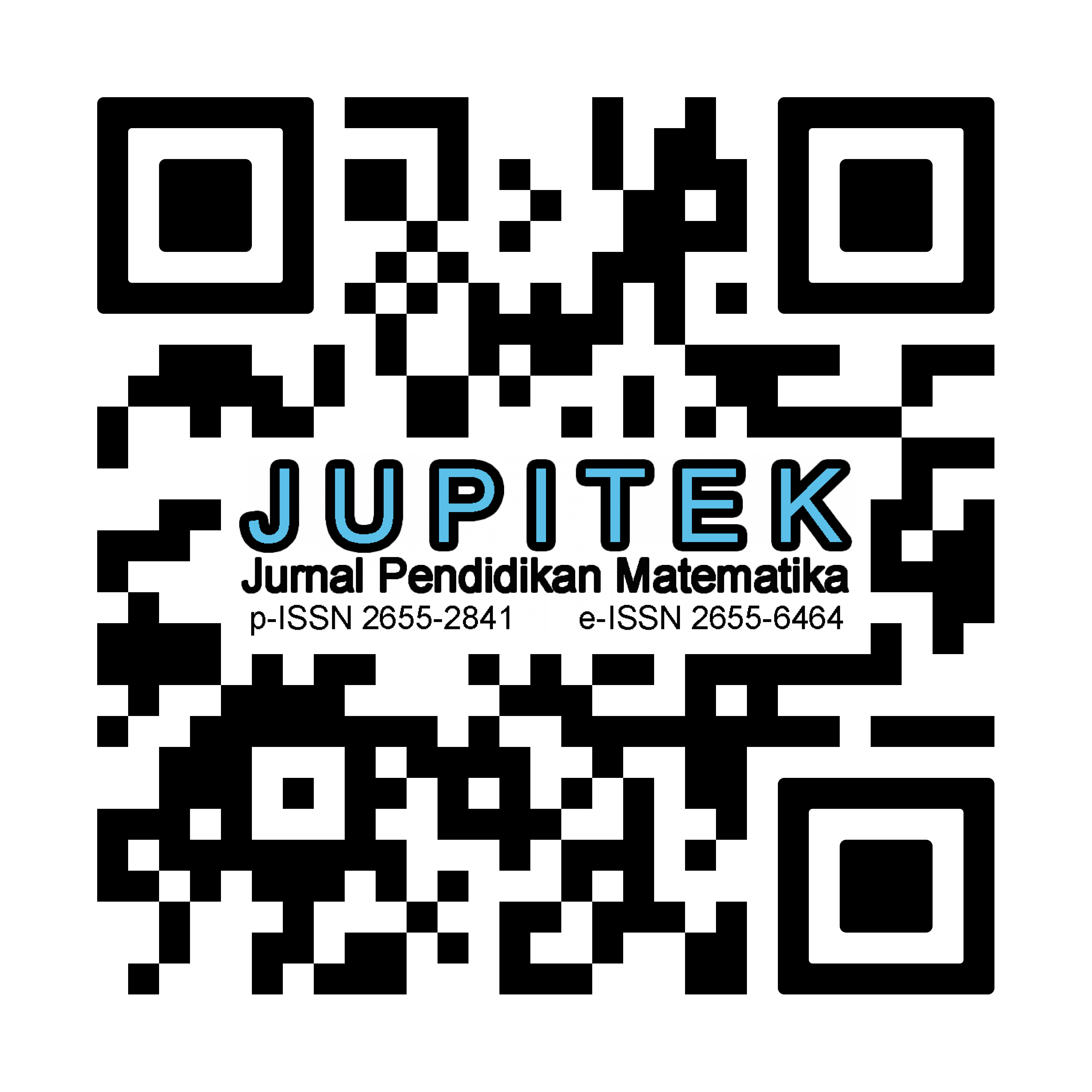KONFLIK KOGNITIF MAHASISWA DALAM MEMAHAMI KONSEP GEOMETRI HIPERBOLIK DAN ELLIPTIK
Abstract
Using schemes of Euclid's geometrical concepts in long-term memory to understand hyperbolic geometry and elliptic geometry concepts with assimilation and accommodation allows for cognitive conflict. This study aims to reduce the occurrence of cognitive conflict by understanding the mathematical content of the three of Euclidean geometries, hyperbolic and elliptic. The research was conduct used descriptive exploratory. The results indicate that Euclid's geometry representation is still used in representing hyperbolic and elliptic geometry so that cognitive conflict occurs. Cognitive conflicts that occur are related to the position of two lines, parallels, two triangles with the same that correspond angles, intersects one of two parallel lines, the number of angles in a triangle, and Sacherri's valid hypothesis. The efforts that can be made to reduce the occurrence of cognitive conflict are to change existing schemes or create new schemes so that the information obtained can be combined into existing schemes in a deductive axiomatic approach to material content through the accommodation process
Downloads
References
Blake, B & Pope, T. (2008). Developmental psychology: Incorporating Piaget’s and Vygotsky’s theories in classrooms.
Budiarto, M. T., Khabibah, S., & Setianingsih, R. (2017). Construction of High School Students’ Abstraction Levels in Understanding the Concept of Quadrilaterals. International Education Studies, 10(2), 148.
Budiarto, M. T., Rahaju, E. B., & Hartono, S. (2017). Students abstraction in re-cognizing, building with and constructing a quadrilateral. Educational Research and Reviews, 12(7), 394-402Dattilio, F. M. (2010). Examining the Scope and Concept of Schema: Should We Look Beyond Cognitive Structures? Psihologijske teme, 19(2), 221-234.
Cancinoâ€Montecinos, S., Björklund, F., & Lindholm, T. (2018). Dissonance and abstraction: Cognitive conflict leads to higher level of construal. European Journal of Social Psychology, 48(1), 100-107.
Dattilio, F. M. (2010). Examining the Scope and Concept of Schema: Should We Look Beyond Cognitive Structures? Psihologijske teme, 19(2), 221-234.
Foster, C. (2011). A slippery slope: Resolving cognitive conflict in mechanics. Teaching Mathematics and Its Applications, 30, 216-221.
Ghosh, V. E., & Gilboa, A. (2014). What is a memory schema? A historical perspective on current neuroscience literature. Neuropsychologia, 53, 104-114.
Gordon, S. (2013). Through the Eyes of Jurors: The Use of Schemas in the Application of Plain-Language Jury Instructions. Hastings LJ, 64, 643.
Eggen, P & Kauchak, D. (2013). Educational Psychology Windows on Classrooms, (9thed). Pearson Education Inc: United States of America.
Hergenhahn, B. R., & Olson, M. H. (2017). Theories of learning. Prenada Media: Jakarta
Kaasila, R., Pehkonen, E., & Hellinen, A. (2010). Finnish pre-service teachers’ and upper secondary students’ understanding of division and reasoning strategies used. Educational Studies in Mathematics, 73(3), 247-261.
Kwon, J., & Lee, G. (2001). What do you know about students’ cognitive conflict: a theoretical model of cognitive conflict process. Proceeding of 2001 AETS annual meeting. Costa Mesa, CA, 309-325.
Lee, G., & Kwon, J. (2001). What do you know about students’ cognitive conflict in science Education: A theoretical modelof cognitive process. In Proceedings of 2001 AETS Annual meeting (pp. 309-325). Costa Mesa, CA: Retrieved from http:// www.rhodes.aegean.gr/ptde
Ormrod, J. E. (2008). Psikologi pendidikan. Jakarta: Erlangga.
Sela, H., & Zaslavsky, O. (2007). Resolving cognitive conflict with peers-is there a difference between two and four?. In Proceedings of the 31st Conference of the International Group for the Psychology of Mathematics Education, 4, 169-176
Ribeiro Piske, F. H., Stoltz, T., de Camargo, D., Blum Vestena, C. L., Machado, J. M., de Freitas, S. P., & dos Reis Taucei, J. (2017). Creation Process during Learning of Gifted Students: Contributions from Jean Piaget. Online Submission, 8, 505-513.
Slavin, R. E. (2008). Educational Psychology Theory and Practice (8thed). Pearson education Inc: United States of America.
Zazkis, R., & Chernoff, E. (2006, November). Examples that change minds. In Psychology of Mathematics Education (p. 756).
Zhang, Z. (2015). Assimilation, accommodation, and equilibration: A schema-based perspective on translation as process and as product. In International Forum of Teaching and Studies, 11, 1/2, p. 84
Copyright (c) 2020 Mega Teguh Budiarto, Rini Setyaningsih

This work is licensed under a Creative Commons Attribution-NonCommercial-ShareAlike 4.0 International License.
License and Copyright Agreement
By submitting a manuscript to Jurnal Pendidikan Matematika (JUPITEK), the author(s) certify and agree to the following terms:
- Originality and Authority: The submitting author is authorized by all co-authors to enter into this agreement. The manuscript describes original work that has not been published previously in a peer-reviewed journal, nor is it under consideration for publication elsewhere.
- Approval: Its publication has been approved by all author(s) and by the responsible authorities of the institutions where the work was carried out.
- Rights: The authors secure the right to reproduce any material that has already been published or copyrighted elsewhere.
- Licensing and Copyright: Authors retain the copyright to their work.
- License Grant: The authors grant Jurnal Pendidikan Matematika (JUPITEK) the right of first publication, with the work simultaneously licensed under the Creative Commons Attribution-NonCommercial-ShareAlike 4.0 International (CC BY-NC-SA 4.0).
- Self-Archiving: Authors are permitted and encouraged to deposit the published version of their article in institutional repositories, on their personal websites, and other academic platforms, with proper acknowledgment of its initial publication in Jurnal Pendidikan Matematika (JUPITEK).






.png)


